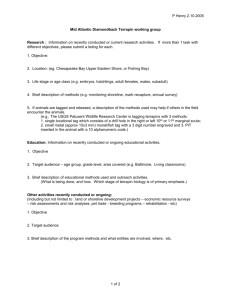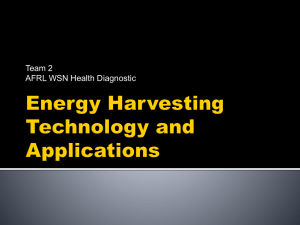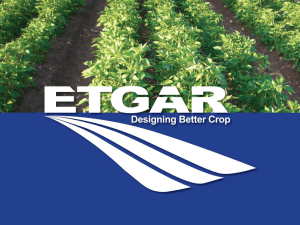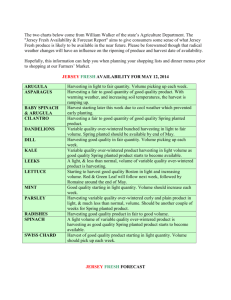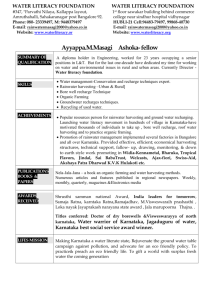WLP_2_Management_Objectives - Ministry of Forests, Lands
advertisement
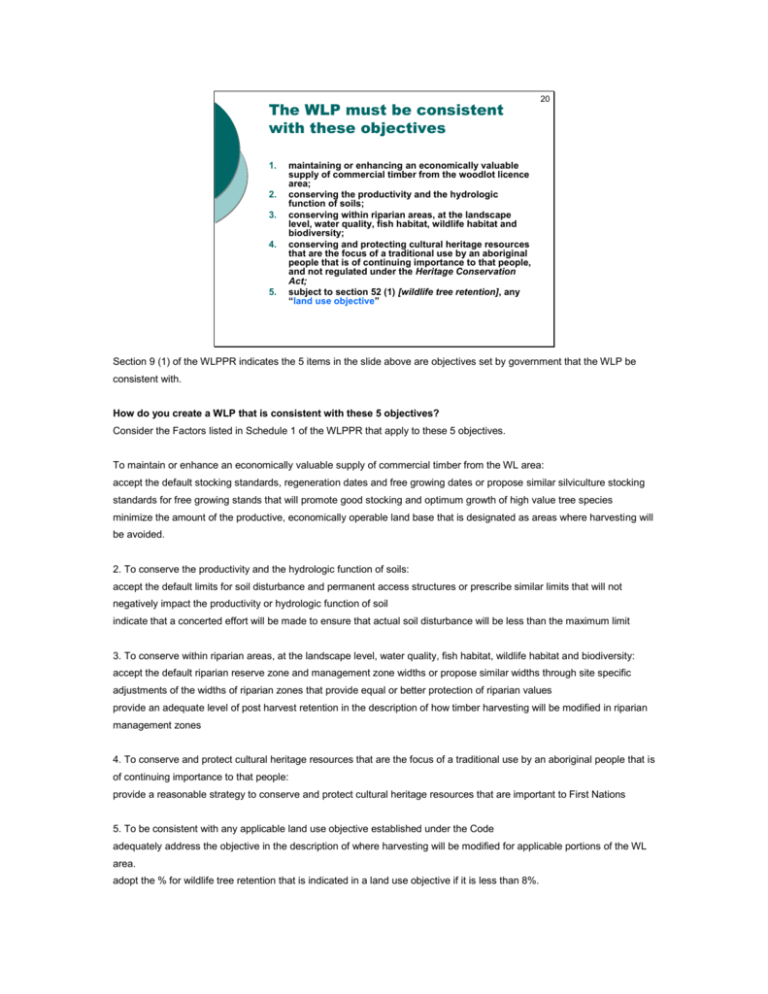
The WLP must be consistent with these objectives 1. 2. 3. 4. 5. 20 maintaining or enhancing an economically valuable supply of commercial timber from the woodlot licence area; conserving the productivity and the hydrologic function of soils; conserving within riparian areas, at the landscape level, water quality, fish habitat, wildlife habitat and biodiversity; conserving and protecting cultural heritage resources that are the focus of a traditional use by an aboriginal people that is of continuing importance to that people, and not regulated under the Heritage Conservation Act; subject to section 52 (1) [wildlife tree retention], any “land use objective” Section 9 (1) of the WLPPR indicates the 5 items in the slide above are objectives set by government that the WLP be consistent with. How do you create a WLP that is consistent with these 5 objectives? Consider the Factors listed in Schedule 1 of the WLPPR that apply to these 5 objectives. To maintain or enhance an economically valuable supply of commercial timber from the WL area: accept the default stocking standards, regeneration dates and free growing dates or propose similar silviculture stocking standards for free growing stands that will promote good stocking and optimum growth of high value tree species minimize the amount of the productive, economically operable land base that is designated as areas where harvesting will be avoided. 2. To conserve the productivity and the hydrologic function of soils: accept the default limits for soil disturbance and permanent access structures or prescribe similar limits that will not negatively impact the productivity or hydrologic function of soil indicate that a concerted effort will be made to ensure that actual soil disturbance will be less than the maximum limit 3. To conserve within riparian areas, at the landscape level, water quality, fish habitat, wildlife habitat and biodiversity: accept the default riparian reserve zone and management zone widths or propose similar widths through site specific adjustments of the widths of riparian zones that provide equal or better protection of riparian values provide an adequate level of post harvest retention in the description of how timber harvesting will be modified in riparian management zones 4. To conserve and protect cultural heritage resources that are the focus of a traditional use by an aboriginal people that is of continuing importance to that people: provide a reasonable strategy to conserve and protect cultural heritage resources that are important to First Nations 5. To be consistent with any applicable land use objective established under the Code adequately address the objective in the description of where harvesting will be modified for applicable portions of the WL area. adopt the % for wildlife tree retention that is indicated in a land use objective if it is less than 8%. The WLP must be consistent with applicable “land use objectives” Land use objectives are objectives established for Resource Management Zones, Landscape Units or Sensitive Areas, under the Code FRPA section 13(3) indicates a WLP need not be consistent with objectives set by government for retention of old forest (OGMAs), seral stage distribution, landscape connectivity, or temporal and spatial distribution of cutblocks (green-up or maximum cutblock size). WLPPR section 52 indicates a land use objective for wildlife tree retention will only apply if it is < 8% and < a % specified in a WLP. 21 FRPA section 13(3) indicates a WLP need not be consistent with objectives set by government to the extent that those objectives pertain to: retention of old forest, seral stage distribution, landscape connectivity, or temporal and spatial distribution of cutblocks. If an objective for “old growth management areas”, seral stage distribution, landscape connectivity (forest ecosystem networks) or temporal and spatial distribution of cutblocks (green up or cutblock size), was established for a Resource Management Zone, Landscape Unit or Sensitive Area, the WLP does not need to be consistent with the objective. WLPPR section 52(1) states the following: Unless exempted under section 78 (1) [minister may grant exemptions], a woodlot licence holder must ensure that the proportion of the woodlot licence area that is occupied by wildlife tree retention areas is no less than the least of the following: (a) the proportion specified for the area in a land use objective; (b) the proportion specified for the area in the holder’s woodlot licence plan; (c) 8% of the woodlot licence area. The WLP must also be consistent with objectives for: 22 a fisheries sensitive watershed water quality for a community watershed the winter survival of specified ungulates, the survival of a species at risk, and the survival of a species of regionally important wildlife an interpretive forest site, recreation site or recreation trail a wildlife habitat area an ungulate winter range a lakeshore management zone for a lake > 5 ha. visual quality in a scenic area Section 9 (2) and section 10 of the WLPPR list the items indicated in the slide above which are objectives set by government that the WLP must be consistent with. For any of these objectives to be valid they would need to have been established under a formal process under the Code or the Government Actions Regulations under FRPA. FRPA section 16(2) indicates the WLP must be consistent with objectives established 4 months before the WLP is submitted for approval, unless an enactment or the order establishing the objective indicates otherwise. It is important for the WL holder to stay informed of new objectives, resource feature, fisheries sensitive watersheds, regionally important wildlife, wildlife habitat features and other items that are currently being established under the Government Actions Regulation. Where these items apply to the WL area there may be WLPPR practice requirements that are linked to newly established objective or item that the WL holder will need to comply even though the WLP was approved before the objective or item was established. 23 New Wildlife Habitat Objectives Visit the MOE website listed below to see if objectives for habitat conservation have been established over the WL area for: species at risk, or specified ungulate species The WL holder must act in a manner consistent with these objectives. ftp://ribftp.env.gov.bc.ca/pub/outgoing/cdc_data/Approved_ FRPR_sec7_WLPPR_sec9_Notices_and_Supporting_Info/ WLPPR section 9(2) and (3) provides a mechanism for the Ministry of Environment to conserve important wildlife habitat in critical areas before a wildlife habitat area can be established for a species at risk or an ungulate winter range can be established for specified ungulate species. NOTE: The Ministry of Environment (MOE) has posted notices under WLPPR 9 establishing objectives set by government for the conservation of habitat for species at risk and specified ungulate species. The notices are available at the following website: ftp://ribftp.env.gov.bc.ca/pub/outgoing/cdc_data/Approved_FRPR_sec7_WLPPR_sec9_ Notices_and_Supporting_Info/ The supporting information with each notice provides text and a PDF map that will provide an indication to the WL holder if the notice affects the WL area. Additional information relating to any applicable notice can be obtained from the MOE regional office and their websites - http://wlapwww.gov.bc.ca/wld/ or http://wlapwww.gov.bc.ca/wld/uwr/index.html or http://wlapwww.gov.bc.ca/wld/identified/index.htm A WL holder must act in a manner consistent with the objective to conserve wildlife habitat that is described in the notice and supporting information that applies to the WL area. 24 Personal Objectives Examine your WL management plan for additional commitments or AAC assumptions that create constraints Consider how you can operate to achieve your personal management objectives given the constraints created by government objectives, regulation practice requirements and your WL management plan 25 Delineating The Land Base 1. Locate government imposed constraints on harvesting, (e.g. ungulate winter range, riparian areas, scenic areas, community watersheds, etc.) Lakeshore Management Zone Resource Features S3 Stream Gavin Lake Scenic Area Mule Deer Winter Range S4 Stream First map areas that constrain harvest and obtain a clear picture of the legal requirements in each of these areas. Riparian reserve and management zones Mule deer winter range Visual sensitivity shown in blue Resource features (red diamonds) Data is available from the Land and Resource Data Warehouse http://srmwww.gov.bc.ca/g/lrdw.html 26 Delineating The Land Base 2. Identify areas where there are management constraints: FN cultural use areas, root rot centers, steep slopes, sensitive soils, natural range barriers, high blowdown potential. low value species or decadent timber, high reforestation cost 3. Decide if and how you should operate in each of these constrained areas or leave them for wildlife tree retention. Decadent Timber Gavin Lake Root Rot Sensitive Soils Steep Slopes Wind Throw Add to the map areas that constrain harvesting or compel it Sensitive soils shown in bright yellow Root disease centers (purple) Windthrow ( gold) Decadent low value timber with high reforestation cost Bark beetle infestation and susceptible timber types If you have a bark beetle infestation or other immediate priority for harvesting carefully consider how you will deal with the situation when you specify areas where harvesting will be modified or you select potential wildlife tree retention areas. Where Harvesting Will be Avoided or Modified 27 The WLP must describe where timber harvesting will be avoided or modified during the term of the WLP to address or protect the following: • resource features • wildlife habitat areas • private property or aboriginal interests • scenic areas • ungulate winter ranges • community and fisheries sensitive watersheds • resource values (retention in riparian management zones) • objectives for a Resource Management Zone, Landscape Unit or Sensitive Area Section 8(3) of the WLPPR requires the WLP to describe where timber harvesting will be avoided or modified during the term of the WLP for the following reasons: (a) to protect resource features; (b) to address the interests of private property owners or aboriginal peoples; (c) to manage resource values including specifying retention of trees in riparian management zones; (d) to address resource management zones, landscape units and sensitive areas; wildlife habitat areas; scenic areas; ungulate winter ranges; community watersheds or fisheries sensitive watersheds . The WLP template provides separate section headings to describe AREAS WHERE TIMBER HARVESTING WILL BE AVOIDED or AREAS WHERE TIMBER HARVESTING WILL BE MODIFIED. The WLP map will also needs to identify the boundaries of areas where harvesting will be avoided and areas where harvesting will be modified unless the area can be adequately described in text (e.g. within 30 m. of a parcel of private property, in riparian reserve zones, etc.) 28 Where Harvesting Will be Avoided Do not show wildlife tree retention areas and riparian reserve zones as areas where you will avoid harvesting. Be careful in designating areas where you will avoid harvesting as WLPPR section 53(1) prohibits “harvesting” in these areas. Refer to the definition of “harvest” to see the full effect of this prohibition. An amendment to the WLP will be needed before any harvesting can be authorized in areas where you indicate you will avoid harvesting. Since the WLP will most likely be approved for 10 years and could be extended for a subsequent 10 years, the WLP should strive to retain maximum flexibility so that conventional harvesting can be carried out on as much of the WL area as possible. It is difficult to predict where harvesting may be warranted over the next 10 to 20 years and creating a WLP that is overly restrictive and may require subsequent amendments is not in the best interests of streamlining administration. According to the Forest Planning and Practices Regulation, the term “harvest”, in relation to timber, means to fell or remove timber, other than under a silviculture treatment, including to (a) yard, deck or load timber, (b) process timber on site, (c) pile or dispose of logging debris, (d) construct excavated/bladed or any logging trails, (e) rehabilitate an area referred to in section 35 (roadside work areas, areas of sensitive soils or an area of compacted soil, within the NAR) (f) carry out sanitation treatments associated with operations referred to in paragraphs (a) to (e); Once you indicate that you will avoid harvesting in an area on a WLP, section 53(1) of the WLPPR prohibits you from carrying out any of the operations listed above on the area. Note: It is probably not possible to obtain authorization the construct a road in an area where you indicate you will avoid harvesting unless no timber harvesting is required and the road is constructed in a way that it doesn’t meet the definition of an excavated or bladed trail. Rather than indicating that harvesting will be avoided in an area it is better to indicate that harvesting will be modified in the area and describe the type of scenarios that may trigger the need to harvest and to what extent harvesting might take place. For example, indicating riparian reserve zones are areas where harvesting will be avoided will eliminate the flexibility to carry out the limited amount of harvesting that is possible under WLPPR section 39. Harvesting in riparian reserve zones is very restricted but not prohibited by the WLPPR so there is no need to eliminate the flexibility provided by the WLPPR by setting riparian reserve zones up as areas where harvesting will be avoided. Where Harvesting will be Modified 29 Be careful in describing where and, in required instances, how you will modify harvesting as: WLPPR section 53(2) requires harvesting to be in accordance with the modifications described in the WLP, and WLPPR section 40(5) restricts the removal of trees from riparian management zones to what is described in the WLP. If a landowner of property contiguous to the WL area was opposed to any harvesting taking place next to his or her private land the WLP could propose that harvesting be modified for a certain distance away from the private land and restricted to the extent necessary to salvage: dead or damaged timber, timber infested with insects or infected with a potentially lethal disease, or that represents a safety or fire hazard. It is best to wait until you have considered all government objectives and constrains, including the strategy to protect cultural heritage resources that are associated with First Nation’s traditional use before finalizing the areas where timber harvesting will be avoided or modified. If you describe how you will modify harvesting in your WLP create wording to provide yourself some flexibility to carry out more extensive harvesting in response to a catastrophic event (e.g. wildfire, windstorm, bark beetle infestation, ice damage, etc). Doing this will avoid the need for amendments to the WLP. 30 Managing Constrained Areas For areas with constraints: Consider if there is a way you can modify your harvesting to achieve desired results. Consider if the area has suitable stand characteristics to become a wildlife tree retention area. Calculate the total area of the WL required for wildlife tree retention and utilize constrained areas if suitable. Recommendation: Don’t indicate you will avoid harvesting an area unless you are legally prohibited from harvesting or you are certain you won’t need to harvest in the area for 10-20 years. Section 53(1) of the WLPPR will prohibit you from harvesting any areas that the WLP indicates are areas where you will avoid harvesting. If at a later date you need to carry out any of the operations that are defined as harvesting in the area you will most likely need to amend the WLP. There is no simple exemptions that the District Manager can grant for the prohibition on harvesting in section 53(1) of the WLPPR. A 600 hectare WL area with a requirement for 8% wildlife tree retention will require 48 hectares to be set aside for wildlife tree retention. Although the wildlife tree retention areas do not need to be mapped in the WLP there is an expectation that if a WL holder was audited they should be able to provide a map showing the minimum amount of wildlife tree retention areas having attributes as described in the wildlife tree retention strategy. 31 Mapping Exercise Identify areas where you will avoid harvesting Identify areas where you will modify harvesting Identify if any of these or other areas are suitable as wildlife tree retention areas Identify where you will need to construct a road in a riparian reserve zone or riparian management zone of a stream, wetland or lake You will need the forest cover attributes of areas you propose as wildlife tree retention areas so you can complete the wildlife tree retention strategy. When you complete the part of the WLP dealing with performance requirements you will need to be aware of any roads you need to construct in a riparian reserve zone or riparian management zone, (including stream crossings).

